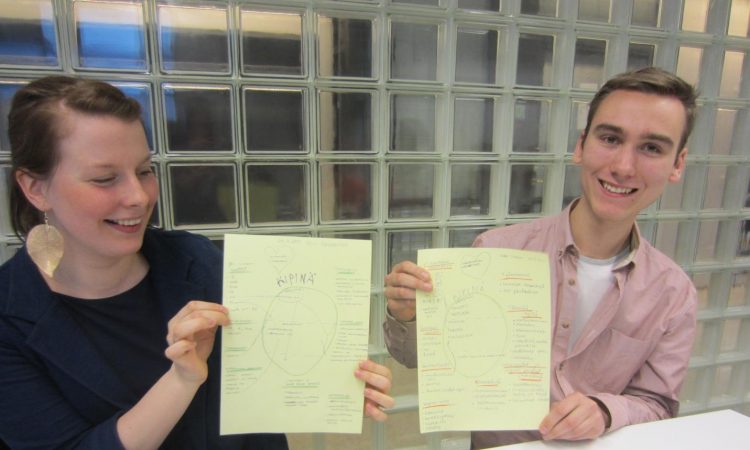Just as in the visual arts, counselling can capture a beautiful moment. This moment, in my definition, arises out of the encounter between the client and the counsellor – and their communication during a shared experience of empowerment or progress. As a counsellor, I capture and visualize this beautiful experience on a counselling chart.
What is a visual counselling chart?
By visualization, I mean analyzing the counselling session and writing it out on the counselling chart by means of text, drawings and colours. I usually take a blank A4-size sheet of paper, pencil and coloured pencils. On the blank paper, I record matters arising from the narratives of the client: main themes, cause-and-effect relations, potential solutions to problems and home assignments. I call this paper a counselling chart.
On the counselling chart, I visualize various counselling situations and themes such as life skills, counselling for studies, motivation, self-knowledge and career. The counselling charts always vary. I draw and write my analysis of the session on the counselling chart, including the details essential to each encounter.
I use visualization as my main counselling method with many of my clients – young people and adults alike.

Benefits of counselling charts
Norman Amundson (2015) has described the visualization of counselling as an active counselling methodology. The counselling chart is one such form of visualization, through mapping. According to R. Vance Peavy (1997, 2004), mapping is a means to make visible the self, activating both client and counsellor.
Minna Kattelus is the author of “KIPINÄ: SPARKS Career Counselling,” a chapter in CERIC’s 2019 publication, Career Theories and Models at Work: Ideas for Practice. Learn more about the book at: ceric.ca/theories.
The counselling chart – a mapping tool – is a joint project of the counsellor and client, and it encourages active participation in the session. Furthermore, it makes the situation more relaxed for the client, since the focus of both people lies mainly on the chart during the dialogic process. The counselling chart functions as a tool for dialogue, externalization and shared observation. All of this supports the self-observation and self-understanding of counsellees (Kattelus, 2019).
Counselling charts also build visibility into counselling. In traditional counselling methods, summaries, notes and assignments might be shared verbally or contained in counsellors’ personal notes; counselling charts can go home with the client. This enables the continuation of counselling even after the session is over. In addition, having the chart gives the client a tool for discussion of their career plans with family and friends, something almost entirely missing in traditional counselling (Kattelus, 2019).
Visualization of career counselling – SPARKS chart
What it is

I have created a visual and structured SPARKS career counselling model for individual counselling and peer group counselling with young people and adults. The objective of the SPARKS model is to make the career counselling process transparent and to help the counsellee visualize the various areas of their life (using the SPARKS chart) that affect career and action planning. The visual and structured SPARKS chart strives to initiate a career-planning process in the counsellee or re-enforce an existing career spark (Kattelus, 2019). The SPARKS model has its theoretical foundation in constructivist approaches, including sociodynamic career counselling (Peavy, 1997, 2004), life design counselling (Savickas, 2012) and contextual action theory (Young & Valach, 2004) (Kattelus, 2019).
Creating a SPARKS chart
To create the SPARKS chart, first, the counsellor draws an oval in the middle of the blank A4-sized sheet of paper, with the title “Career SPARK” above it. This is the place where sparks related to further studies or work – that is, the primary and secondary options of the career plan – are marked toward the end of the session. At first, this oval remains empty, and the counselling goes forward by examining the Boundary Conditions. These conditions are past and present education/training (and success in these), past and present favourite subjects and hobbies, extra-curricular activities, work experience, what is important to the client at work, as well as strengths and features needing development. (You can learn about other tools in the SPARKS counselling model at minnakattelus.com and at kipinauraohjaus.com.)
The group counselling model
When using this model in a group counselling setting, the counsellor teaches the SPARKS career counselling model and then the participants work in pairs to write out one another’s SPARKS charts. Whenever SPARKS career counselling is carried out in peer groups (ideally with six participants), the counselling is enhanced by having the counsellees draw contrasts between individuals. In SPARKS peer groups, the clients actively function in the roles of both peer counsellors and peer counsellees, thus strengthening their participation and agency (Kattelus, 2019).
A holistic approach
SPARKS Career Counselling and SPARKS charts take into account the holistic planning, goal-directed actions, self-efficacy and self-understanding of the counsellee, along with the client’s interest in the future and ways to strengthen his or her options. For counsellees, the SPARKS Career Counselling process means analyzing their objectives and options, strengthening their motivation and self-confidence, and bolstering their belief in a positive future. The approach helps them to mentally link themselves to the boundary conditions of their vocational preferences.




